Wine Club Barrel Tasting & Tour
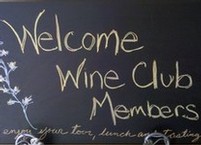
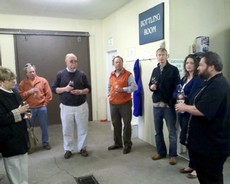
What a spectacular weekend! On Saturday, we hosted a Wine Club Barrel Tasting & Tour here at the winery on Keuka Lake! It was a great behind the scenes experience for our Wine Club members. They started out in the cellar with a private barrel tasting and tour with the Winemaker, Bernard Cannac and Owner/Grapegrower, John Ingle. Bernard spent about an hour explaining the process of wine making and how the production staff works. The assistant winemaker, Brian Barry, was also there as our token “cellar rat” offering another point of view.
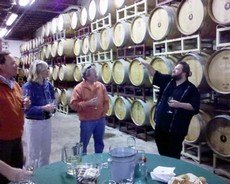
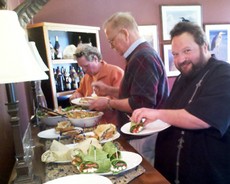
In the cellar, the Wine Club members were treated to a taste of two never before released wines. The first sample was a tank sample of our 2009 Riesling Reserve. This new reserve wine is going to be a dry Riesling that will have grapes from two different vineyards, our estate vineyard and Ingle Vineyard (John’s vineyard on Canandaigua Lake). The members seemed pleased with the progress of the young wine. The next sample was the 2009 Cabernet Sauvignon Reserve, a surefire hit with the crowd! The winemakers pointed out the fact that the barrel samples are only a suggestion of what the finished wine will taste like. Tasting out of the barrel or the tanks gives you a glimpse into how the wine will taste once fully aged.
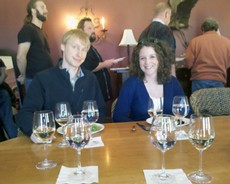
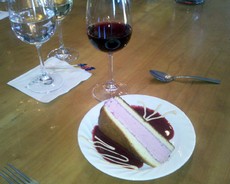
They wine club members were also able to see the bottling line and got some new information that is not being released to the public yet!!! Stay tuned!
After the tour we were off to the conference room for an amazing lunch that was produced by our very own Mike “Ollie” Oliver, our Café Manager and Head Chef! Ollie offered an amazing selection of food for lunch including, Chicken Caesar wraps, Calabrese wraps, Roast Beef Panini with an herbed Horseradish mayo with sautéed peppers and onions, and my personal favorite the Turkey Panini with a Cajun Aioli sauce. One of the highlights of the meal was the beautiful fruit tray that paired beautifully with the Classic Muscat wine. For dessert large smiles were came out from the crowd when we presented the Charlotte a la Framboise, a cool and creamy raspberry mousse sandwiched between two layers of fluffy cake. The cake was the perfect pairing for the barrel sample of the 2010 Blaufrankish. The exquisitely prepared meal was thoroughly enjoyed by all in attendance.
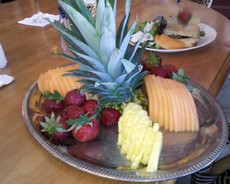
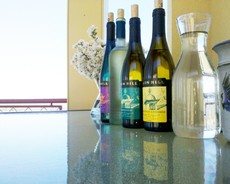
After a delightful meal we headed up to the tower to finish off the afternoon with a sampling of all of the wines from Ingle Vineyard and the newest vintages (not yet released) from the Eclipse Series. During the discussion, John and Bernard explained how in the Ingle Vineyard Cabernet Franc, field blending is part of the wine making process. A field blend is a wine that is produced from two or more different grape varieties inter-planted in the same vineyard. In the days before precise varietal identification, Ingle Vineyard was thought to have been planted with 100% Cabernet Franc, but upon closer inspection we noticed that there is about 10-15% Cabernet Sauvignon intermingled in the vineyard. The field blend of the Cabernet Franc with a smattering of Cabernet Sauvignon allows Bernard and Brian an effortless, though inflexible, blending.
Next weekend brings us round two of the Wine Club Barrel Tasting & Tour. I am sure it will be equally amazing…
Wine Club barrel tasting & tour event
Last week we had what seemed to be spring’s prelude, only to have the cold come back. Looks like spring wants to pop out, but winter is not quite done with us yet. In the vineyard, we spent the month of March pruning the Riesling, then the Muscat. The weather hasn’t been cooperating too much, but we’re getting by. The couple of warm days we had last week were enough to make the vines “cry”: the sap is flowing in the plant, sign that the vine is getting out of its dormancy, dawn of a new growing season. In the cellar, Brian keeps pushing things along: the 2010 reds are in barrels for the most part, and we are catching up on our bottling, if this machine would only co-operate…
On April 22nd, students from SUNY Morrisville will be visiting us. Brian will give them a tour of the winery, since I will be in France visiting my family whom I haven’t seen for over three years.
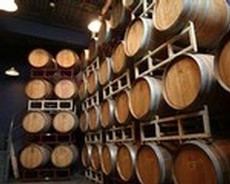 On April 30th and May 7th, we will be hosting an event for our wine club members. It will be a three hour event, including a cellar tour with a barrel tasting, wine tasting in the tower (weather permitting), and a tasty luncheon prepared by Ollie, The Blue Heron Café’s chef, which should open for the season by the end of May. Depending on the weather, we will also take our wine club members out on the vineyard for an overview: we might be able to see how the new shoots are evolving. It is hard to tell now when budbreak will be, though, and how early or late the season will actually start. Last year we were burning hay bails against spring frost from late April until early May.
On April 30th and May 7th, we will be hosting an event for our wine club members. It will be a three hour event, including a cellar tour with a barrel tasting, wine tasting in the tower (weather permitting), and a tasty luncheon prepared by Ollie, The Blue Heron Café’s chef, which should open for the season by the end of May. Depending on the weather, we will also take our wine club members out on the vineyard for an overview: we might be able to see how the new shoots are evolving. It is hard to tell now when budbreak will be, though, and how early or late the season will actually start. Last year we were burning hay bails against spring frost from late April until early May.

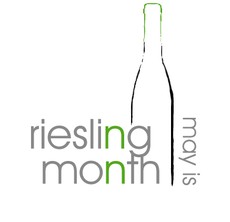 We’ll be participating with Spring into Riesling in April and May is Riesling month, we will be showcasing a Vertical Ingle Vineyard Riesling tasting. We’ll let you know in our newsletter (sign up here). This special tasting will also be available at our two satellite locations, on Seneca Lake and at Bristol on Canandaigua Lake.
We’ll be participating with Spring into Riesling in April and May is Riesling month, we will be showcasing a Vertical Ingle Vineyard Riesling tasting. We’ll let you know in our newsletter (sign up here). This special tasting will also be available at our two satellite locations, on Seneca Lake and at Bristol on Canandaigua Lake.
We are slowly getting away from winter, which means we are gearing up for the season, in the vineyard, in the cellar, where it never stops, and in the tasting room. Sometimes the production crew gets to participate with helping to set up events, but when the party’s over, we get back to the cellar or the vineyard. It’s nice to take a break and get involved in a few key events. Group effort! Click here for details if you’re interested in attending the wine club barrel tasting and tour event.
What happens after fermentation
By Bernard Cannac, Winemaker
After all the excitement of harvest and the fermentations, I enjoy the quiet months of winter. By now, the 2009 reds are aging in barrels and the older vintages are maturing. The 2009 whites have to be prepared before being bottled in the spring and summer.
Like Brian explained in his January 15th blog, the white wines have to be treated with bentonite in order to be protein stable or heat stable. After the fermentation, the wine contains a lot of proteins, some of them coming from the yeasts’ cells. But too many proteins would lead the wine to turn cloudy if it was to be exposed to some heat. If you leave a bottle of white wine, or Rosé or Blush sitting in a car for hours in the summertime, the wine might turn cloudy or hazy. Under heat, proteins tend to form a haze. To prevent this to happen, bentonite is added to the wine. It will attach itself to the proteins in suspension in the wine. The result is a heavy molecule, which will drop down to the bottom of the tank due to its weight. The wines are racked after about one to two weeks after the bentonite addition in order to give it enough time to settle down to the bottom of the tank. Then, we just have to pump the clear wine and discard the sediments left at the bottom of the tank. A gross filtration will take care of any molecules that still might be in suspension.
The other stabilization we have to look after is called cold stability. If you have stored a white, Rosé or Blush wine in the refrigerator to chill it, you might notice that some white or sometimes pink crystals have formed in the bottom of the bottle. No, it is not sugar or sand, and it is not dangerous. If you were to drink some with your wine, the only inconvenience would be that it has a grainy texture and it would feel weird in your palate. One of the most important acids present in grape juice is tartaric acid. Grape juice also naturally contains potassium. When these two compounds react together, they form a crystal called potassium tartrate. This reaction happens faster at colder temperatures. That is why a wine that has not been properly stabilized will produce these crystals when being refrigerated. To avoid this happening in the bottle, we actually make the reaction happen in the tank. There are two ways to induce this: we can chill the tank down to about 28 degrees Fahrenheight and wait for about three weeks or we can add some cream of tartar to the chilled wine. We choose the latter because the stabilization happens faster, in a matter of days instead of weeks. The cream of tartar method is also called “seeding” because the small crystals of cream of tartar induce the formation of tartrates around each “seed” of tartar. When the crystal becomes heavy enough, it drops down to the bottom of the tank. Again, we rack and filter the clear wine and discard the sediments. The red wines get stable after their aging in the barrels, and they should not be chilled, so we do not have to heat and cold stabilize them. Moreover, consumers are more forgiving when they notice sediments in a bottle of red wine.
At this time of the year, we also are busy pruning the vineyard and doing some labeling before getting into bottling some 2007 and 2008 reds and the 2009 whites. I hope it wasn’t too technical and that it answered a couple of questions you might have had. Cheers!
The root cellar and freezers are ready for winter
By John Ingle, Owner/Grapegrower
The end of the harvest season is a time of mixed emotions. There is the feeling of satisfaction and completeness as another vintage comes full cycle and all the work – pruning, tying, cultivating, picking, etc. yields the bounty of a successful harvest. There is the apprehension as to how the wine will turn out. Will the Rieslings and Chardonnays be crisp and bright, will the Pinot Noirs and Cabernets be rich and bold, will the dessert wines be tantalizing? As the baton is passed from grower to winemaker, there is a bond and a trust that is renewed and cemented every year.
Along with the completion of the vineyard harvest, there is also the grand finale of the garden growing season. The freezer is full of bags of peas, spinach, beans and all kinds of berry fruits. The root cellar is loaded up with potatoes, carrots, parsnips, cabbages, onions and brussels sprouts. The little freezer has sweet cider and grape juice, frozen so that it will be as fresh and delicious all winter as it was the day it was pressed. It all adds up to a lot of work that has been accomplished and the prospect of a long, cold winter enjoying the fruits and bounties of our labor. The cycle of life: plan-work-produce-enjoy-plan again.
